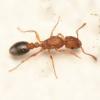- Formiculture.com
- Forums
- Gallery
- Members
- Member Map
- Chat

C. discolor
Started By
JesseTheAntKid
, Mar 10 2024 8:53 AM
1 reply to this topic
#1
 Offline
-
Posted March 10 2024 - 8:53 AM
Offline
-
Posted March 10 2024 - 8:53 AM
I have verified discolor queens. I know they are discolor because of the elevated front thorax for the first pair of legs, which matches C. discolor. I caught them a week ago. Are they supposed to get larvae this fast? Are the larvae supposed to be orange? Because two queens have larvae and they are orange.
Currently keeping: Pheidole obscurithorax (FINALLY I CAN STUDY THEM AND HAVE THEIR COOL MAJORS ![]() ), Tetramorium bicarinatum, Solenopsis spp. (probably xyloni, the queens are tiny hehe)
), Tetramorium bicarinatum, Solenopsis spp. (probably xyloni, the queens are tiny hehe)
Wanting: Atta texana, Camponotus planatus (PLEASE PLEASE PLEASE CAN SOMEONE HOOK ME UP WITH ATTA)
Previously kept: Monomorium minimum, Pheidole dentata
"ATTAAAAAAAAAAAA!!!!!!!!!!!" -Me
"AAAAAAAATTTTTTTTTAAAAAAAAAAAAAAAAAAAAAAAAAA!!!!!!!!!!!!!!!!!!!!!!!!!!!!!!!!!!!!!!!!!!!!!!!!" -Even more me
"AAAAAAAAAAAAAAAAAAAAAAAAAATTTTTTTTTTTTTTTTTTTTTTTTTTTTTTTTTAAAAAAAAAAAAAAAAAAAAAAAAAAAAAAAAAAAAAAAAAAAAAAAAA!!!!!!!!!!!!!!!!!!!!!!!!!!!!!!!!!!!!!!!!!!!!!!!!!!!!!!!!!"- Me personified
#2
 Offline
-
Posted March 10 2024 - 1:24 PM
Offline
-
Posted March 10 2024 - 1:24 PM
Couple things:
The identification characteristic you cited (elevated front thorax for first pair of legs) is not the separating characteristic from similar species like the far more common C. decipiens. To distinguish the two, a head view displaying the presence or lack of malar hairs is needed.
In Camponotus, the eggs and larvae may not be "regular" colored, especially during founding. I have had queens lay orange, reddish, and pinkish eggs. This is normal and does not affect the brood.
- futurebird, rptraut, Flu1d and 1 other like this
1 user(s) are reading this topic
0 members, 1 guests, 0 anonymous users















